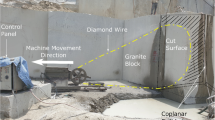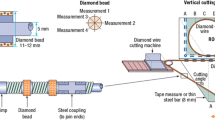Abstract
Cutting performance of diamond wire saw is a key factor influencing mine planning, production scheduling, and equipment selection for dimension stone quarries. It is normally measured in terms of cutting rate. Rock samples collected from various granite and marble quarries in India were tested in laboratory to determine their physico-mechanical properties. Cutting rate of diamond wire saw was measured in the field studies during the actual cutting process in quarries. Using these laboratory determined properties and the cutting rate, a multiple linear regression model has been developed to predict the cutting rate of diamond wire saw. Physico-mechanical properties of rocks determined in laboratory are used as independent variables and cutting rate as predictor variable in the regression model. The study indicates that the cutting rate increases with a decrease in most of the hardness and strength parameters of rock. The final model is tested for its goodness of fit indicating a significant linear relation between cutting rate and physico-mechanical properties, namely tensile strength, slake durability index, and Cerchar hardness index with regression coefficient of 94%. The resulting model can be used suitably for different types of hard to medium hard and soft dimension stones. The generalized model for estimating the cutting rate becomes a handy tool for mining engineers to work out operating efficiency, expenses, planning etc. of the dimension stone block cutting.




Similar content being viewed by others
References
Almasi SN, Bagherpour R, Mikaeil R, Ozcelik Y, Kalhori H (2017) Predicting the building stone cutting rate based on rock properties and device pullback amperage in quarries using M5P model tree. Geotech Geol Eng 35:1311–1326. https://doi.org/10.1007/s10706-017-0177-0
Bayram F (2013) Prediction of sawing performance based on index properties of rocks. Arab J Geosci 6:4357–4362. https://doi.org/10.1007/s12517-012-0668-5
Ersoy A, Atici U (2004) Performance characteristics of circular diamond saws in cutting different types of rocks. Diam Relat Mater 13:22–37. https://doi.org/10.1016/j.diamond.2003.08.016
Harrell Jr FE, with contributions from Charles Dupont, et al (2016) Hmisc: Harrell Miscellaneous
Heron MA (1953) The geology of central Rajasthan; Meomoirs of the the Geological Survey of India
Jain SC, Rathore SS (2011) Prediction of cutting performance of diamond wire saw machine in quarrying of marble: a neural network approach. Rock Mech Rock Eng 44:367–371. https://doi.org/10.1007/s00603-011-0137-6
James G, Witten D, Hastie T, Tibshirani R (2013) An introduction to statistical learning. Springer New York, New York, NY
Käsling H, Thuro K (2010) Determining rock abrasivity in the laboratory. Proc Eur Rock Mech Symp (EUROCK 2010) 1–4
Khademian A, Bagherpour R, Almasi SN, Alaei M (2015) Optimum distance between cutting machine and working face in travertine exploitation with diamond wire cutting method. In: Proceedings of 24th International Mining Congress and Exhibition of Turkey. pp 1103–1110
Mikaeil R, Ozcelik Y, Ataei M, Shaffiee Haghshenas S (2016) Application of harmony search algorithm to evaluate performance of diamond wire saw. J Min Environ. https://doi.org/10.22044/jme.2016.723
Najmedin Almasi S, Bagherpour R, Mikaeil R, Ozcelik Y (2017) Analysis of bead wear in diamond wire sawing considering the rock properties and production rate. Bull Eng Geol Environ 76:1593–1607. https://doi.org/10.1007/s10064-017-1057-9
Ozcelik Y, Yilmazkaya E (2011) The effect of the rock anisotropy on the efficiency of diamond wire cutting machines. Int J Rock Mech Min Sci 48:626–636. https://doi.org/10.1016/j.ijrmms.2011.04.006
Özçelik Y, Kulaksız S, Çetin MC et al (2002) Assessment of the wear of diamond beads in the cutting of different rock types by the ridge regression. J Mater Process Technol 127:392–400. https://doi.org/10.1016/S0924-0136(02)00429-6
Ozcelik Y, Polat E, Bayram F, Ay AM (2004) Investigation of the effects of textural properties on marble cutting with diamond wire. Int J Rock Mech Min Sci 41:1–7. https://doi.org/10.1016/j.ijrmms.2004.03.046
R Core Team (2017) R: A language and environment for statistical computing
RStudio Team (2016) RStudio: integrated development environment for R
Sadegheslam G, Mikaeil R, Rooki R, Ghadernejad S, Ataei M (2013) Predicting the production rate of diamond wire saws using multiple nonlinear regression analysis. Geosystem Eng 16:275–285. https://doi.org/10.1080/12269328.2013.856276
Simpson, Edward H (1951) The interpretation of interaction in contingency tables. J R Stat Soc 238–241
Tönshoff HK, Hillmann-Apmann H (2002) Diamond tools for wire sawing metal components. Diam Relat Mater 11:742–748. https://doi.org/10.1016/S0925-9635(01)00727-0
Yavuz H, Ugur I, Demirdag S (2008) Abrasion resistance of carbonate rocks used in dimension stone industry and correlations between abrasion and rock properties. Int J Rock Mech Min Sci 45:260–267. https://doi.org/10.1016/j.ijrmms.2007.04.003
Yilmazkaya E, Ozcelik Y (2015a) Development of cuttability chart for a limestone cutting with monowire cutting machine. In: 49th U.S. rock mechanics/Geomechanics symposium, 28 June-1 July, San Francisco, California. American Rock Mechanics Association
Yilmazkaya E, Ozcelik Y (2015b) Development of cuttability chart for a marble cutting with monowire cutting machine. In: International Conference on Stone and Concrete Machining (ICSCM). pp 73–85
Acknowledgements
The authors are thankful to the management of various quarry owners of dimension stone quarries who provided logistic supports and necessary information for conducting the field studies and collection of various rock samples. The authors are also thankful to the M.Tech Students, Mr. Saichand, and Mr. Sopan Dev for the assistance provided by them in field and laboratory studies. This study forms a part of the ongoing doctoral research of the first author. Assistance provided by the concerned personnel of various laboratories in IIT (ISM) Dhanbad is highly acknowledged. The views expressed in this paper are those of the authors and not necessarily of the organization to which they belong.
Author information
Authors and Affiliations
Corresponding author
Rights and permissions
About this article
Cite this article
Rajpurohit, S.S., Sinha, R.K., Sen, P. et al. Influence of physico-mechanical properties of Indian dimension stones on cutting rate of diamond wire saw. Arab J Geosci 11, 564 (2018). https://doi.org/10.1007/s12517-018-3913-8
Received:
Accepted:
Published:
DOI: https://doi.org/10.1007/s12517-018-3913-8




